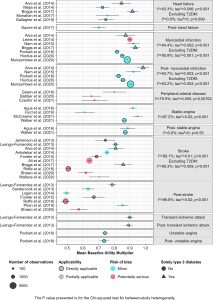Policy-makers often use mathematical models to decide whether new health interventions are cost-effective. These models require estimates of health-related quality of life for the relevant conditions. It is important that these estimates are accurate. Otherwise, policy-makers might not fund the right interventions. Modelling guidelines suggest using systematic reviews to find health-related quality of life evidence.
We recently updated economic evidence for statins as preventive treatment for cardiovascular disease. The health-related quality of life estimates in the previous model had become outdated. Therefore, we searched for up-to-date estimates using a systematic review of published evidence.
Statins can help prevent both acute cardiovascular events and long-term cardiovascular conditions. Myocardial infarction (heart attack), heart failure and unstable angina are acute events affecting the heart. Stroke and transient ischemic attack are acute events affecting the brain. Stable angina and peripheral arterial disease are long-term cardiovascular conditions.
We searched for studies estimating health-related quality of life for these seven conditions. We included studies from any country which used a recognised tool to measure health-related quality of life. We listed the country, tools and health conditions for the 403 studies that we included. We separated estimates for the year of diagnosis with those for later years.
UK policy-makers require the Euroqol 5-dimension (EQ5D) measure of health-related quality of life. We analysed estimates from 29 UK studies using the EQ5D. First, we judged risk of bias and applicability using checklists that we made for the purpose. Second, we calculated the effects of the conditions on health-related quality of life. To do this, we divided estimates for the conditions by those for similar people without the conditions. Multiplying previous health-related quality of life by these numbers (see figure) gives health-related quality of life for the condition.

For most conditions, differences in health-related quality of life effects between studies were larger than we expected. This is likely to be because they had different eligibility criteria. Our applicability checklist classed studies recruiting subgroups of conditions as partially applicable. But some studies did not report full eligibility criteria. We considered choosing studies recruiting large percentages of the populations with the conditions. But doing this gave an unrealistic order of effects between conditions.
We chose health-related quality of life effects for our model using four rules. First, we prioritised estimates that we judged to be low risk of bias and directly applicable. Second, we chose estimates for related conditions from the same studies when possible. Third, we tried to make sure that the order of effects between conditions was realistic. Fourth, we preferred studies covering larger percentages of the populations with the conditions.
Not only should modellers use systematic reviews to find health-related quality of life evidence. They should also judge the risk of bias and applicability of the evidence they find. This is so they do not rely on evidence from a study reporting a population that is not typical. For models considering many conditions, our rules for choosing evidence may also apply. These ensure that evidence is consistent and coherent across conditions.
